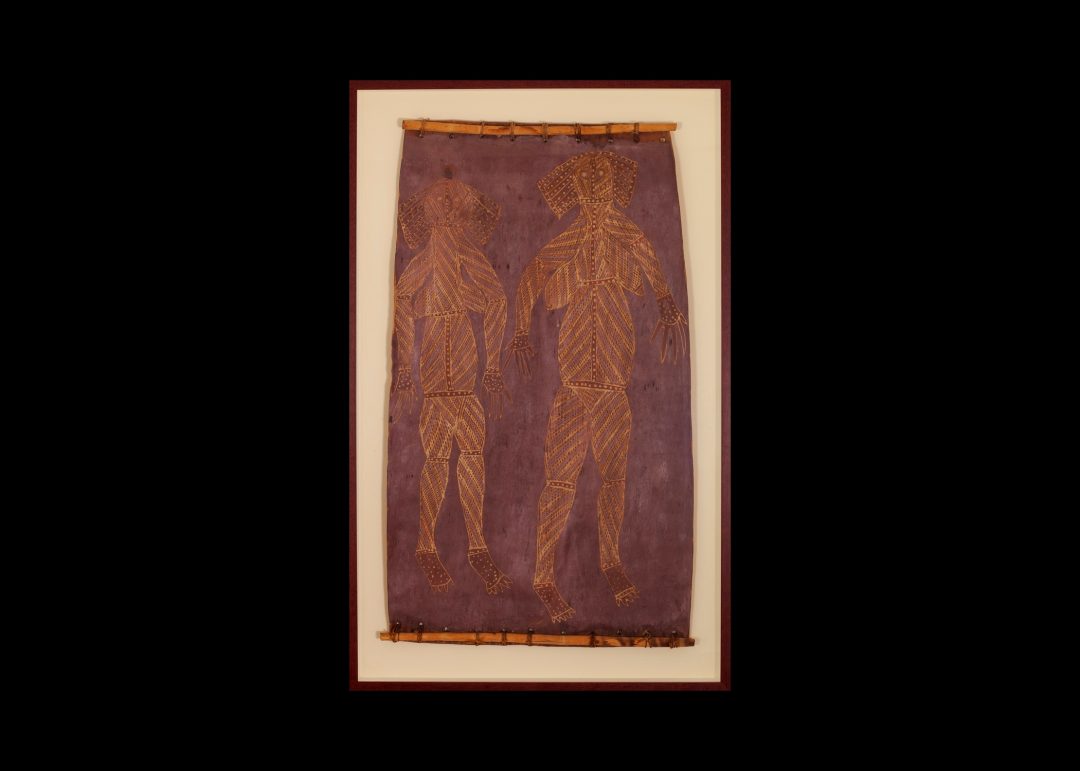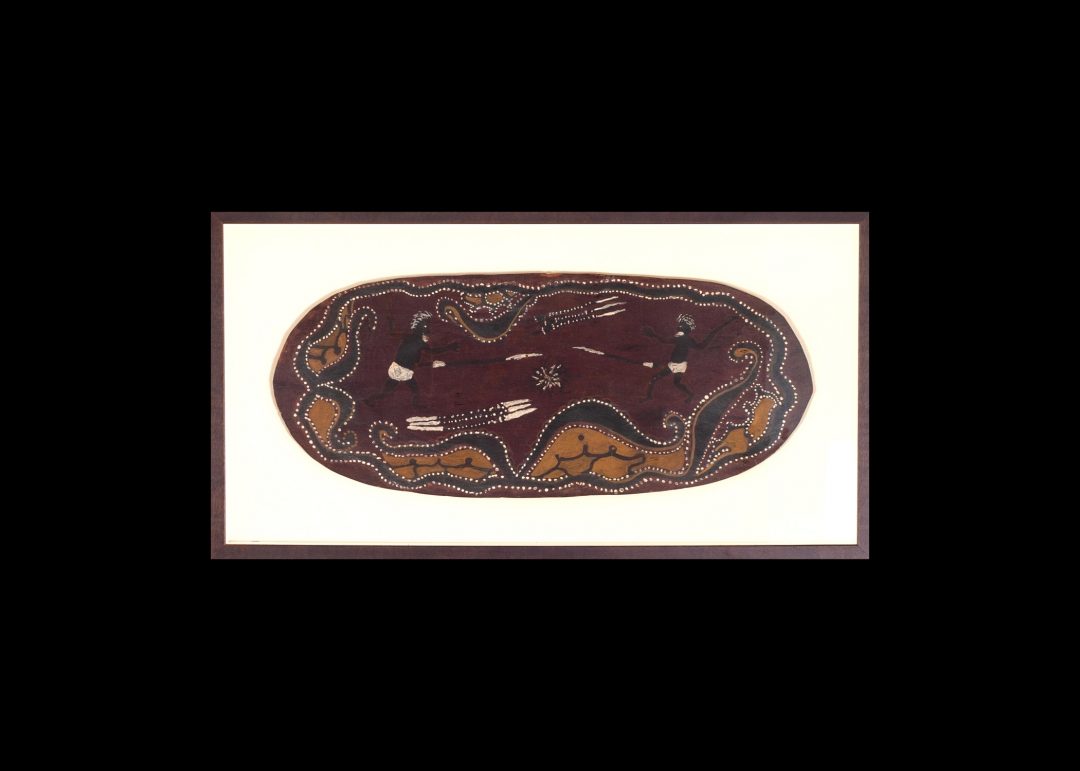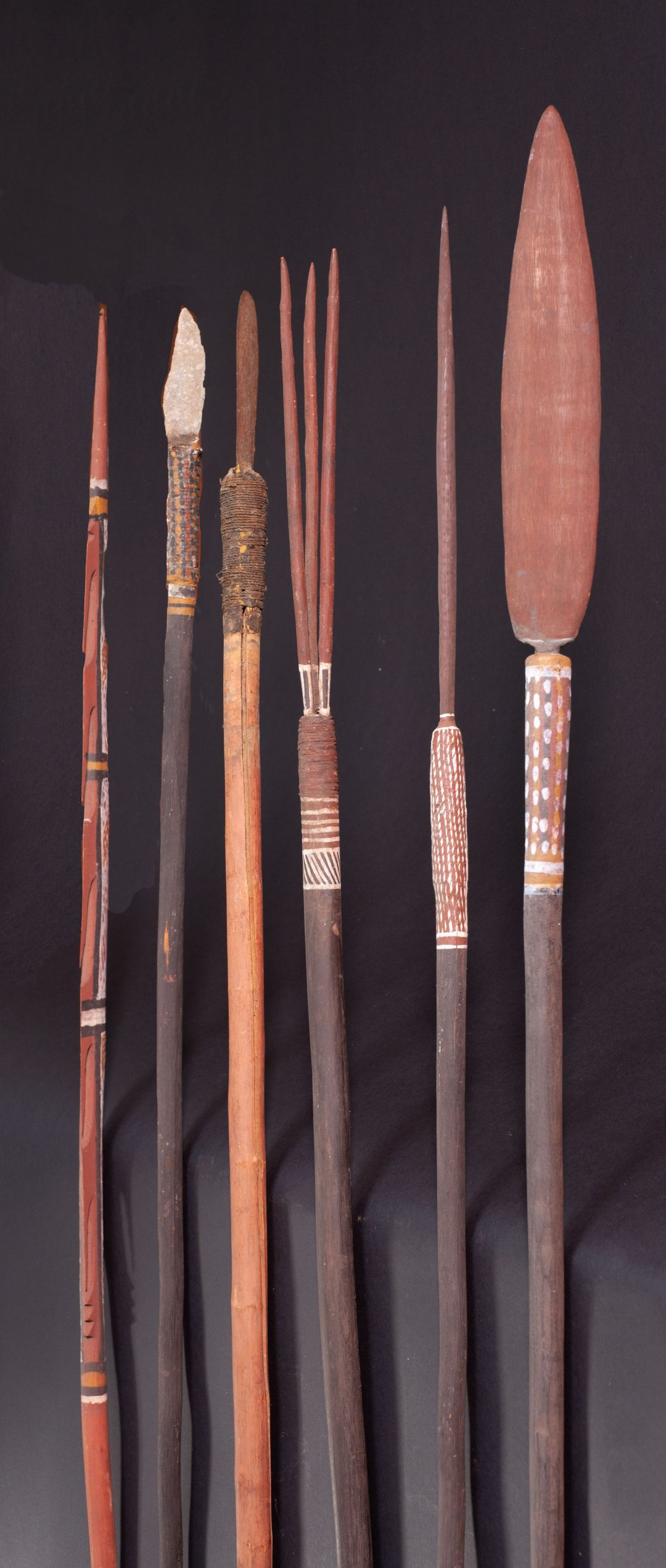Larrtjanga Ganambarr 1932-2000
- TitleThe Crocodile, the Possum and The Ibis Men (Constellation of Scorpio)
- ArtistLarrtjanga Ganambarr 1932-2000
- LocationCentral Arnhem Land, Northern Territory
- Date1966
- Size93cm (L) x 51cm (W)
- PriceSOLD
Bark painting by Larrtjanga Ganambarr 1932-2000
The Crocodile, the Possum and The Ibis Men (Constellation of Scorpio)
Collected 1966
For a very similar work refer to the National Museum of Australia website.
“In the Dreamtime the wongar spirit people held a big mortuary ceremony at Dararwoi in Arnhem Bay. Both moieties were dancing, 2 brolga men are shown, they are the songmen, the possum man Gabari is playing the didjeridoo, as the ceremony ended they changed into natural species. In the centre are two clapsticks and the didjeridoo which they dropped when they changed shapes. The camp fire is also shown the two higher stars are the Brolga men and the lower star is the possum. The crocodile man who was also present is shown in the lower part of the painting he appears as a cluster of stars in the sky.
This bark painting is in exceptional condition very straight with no cracking or pigment loss.
Statement of significance
The Aboriginal and Torres Strait Islander Affairs Art collection comprises 2050 artworks and other objects. The artworks – which numerically dominate the collection – were produced by Aboriginal and Torres Strait Islander communities throughout Australia. The accumulation of these artworks into a single collection has resulted from the choices and selections made during a 38 year period by a variety of staff working for the Council for Aboriginal Affairs (CAA), the Department of Aboriginal Affairs (DAA), the Aboriginal Development Commission (ADC) and the Aboriginal and Torres Strait Islander Commission (ATSIC) at the national, regional and local levels.
The collection spans the years following the 1967 referendum, when dramatic changes in the governance of Aboriginal people took place, up to 2005 when the Aboriginal and Torres Strait Islander Commission was dissolved. It provides a snapshot of the diversity and changes in Indigenous art and its representation which occurred during the period of its formation. The small number of ‘non-art’ objects in the collection is also significant in providing insights into the working of the various Commonwealth bodies involved in Indigenous affairs. As well as the significance of many of the individual pieces, the collection is also significant as a whole, as a complex artefact stemming from Australia’s history of governance of Australian Indigenous peoples.
Bark painting by Larrtjanga Ganambarr 1932-2000
The Crocodile, the Possum and The Ibis Men (Constellation of Scorpio)
Collected 1966
For a very similar work refer to the National Museum of Australia website.
“In the Dreamtime the wongar spirit people held a big mortuary ceremony at Dararwoi in Arnhem Bay. Both moieties were dancing, 2 brolga men are shown, they are the songmen, the possum man Gabari is playing the didjeridoo, as the ceremony ended they changed into natural species. In the centre are two clapsticks and the didjeridoo which they dropped when they changed shapes. The camp fire is also shown the two higher stars are the Brolga men and the lower star is the possum. The crocodile man who was also present is shown in the lower part of the painting he appears as a cluster of stars in the sky.
This bark painting is in exceptional condition very straight with no cracking or pigment loss.
Statement of significance
The Aboriginal and Torres Strait Islander Affairs Art collection comprises 2050 artworks and other objects. The artworks – which numerically dominate the collection – were produced by Aboriginal and Torres Strait Islander communities throughout Australia. The accumulation of these artworks into a single collection has resulted from the choices and selections made during a 38 year period by a variety of staff working for the Council for Aboriginal Affairs (CAA), the Department of Aboriginal Affairs (DAA), the Aboriginal Development Commission (ADC) and the Aboriginal and Torres Strait Islander Commission (ATSIC) at the national, regional and local levels.
The collection spans the years following the 1967 referendum, when dramatic changes in the governance of Aboriginal people took place, up to 2005 when the Aboriginal and Torres Strait Islander Commission was dissolved. It provides a snapshot of the diversity and changes in Indigenous art and its representation which occurred during the period of its formation. The small number of ‘non-art’ objects in the collection is also significant in providing insights into the working of the various Commonwealth bodies involved in Indigenous affairs. As well as the significance of many of the individual pieces, the collection is also significant as a whole, as a complex artefact stemming from Australia’s history of governance of Australian Indigenous peoples.




